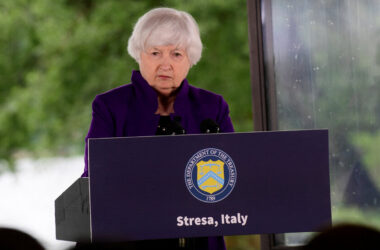Twelve months ago, Tom Lee bet that 2023 was going to turn out just fine.
While many of his peers on Wall Street were sounding the alarm over an impending economic downturn, Mr. Lee, a stock market strategist who spent more than a decade running J.P. Morgan’s equity research before setting up his own firm, forecast in December 2022 that falling inflation and economic resilience would buck the broadly bearish mood.
Mr. Lee was right. Despite political brinkmanship over the nation’s debt ceiling, a banking crisis in March, fears over the cost of funding the government’s fiscal deficit, a continuing war in Ukraine and fresh conflict in Israel, the core of Mr. Lee’s prediction came to fruition in 2023. Inflation has fallen, unemployment remains low, and the S&P 500 has risen 24 percent.
Most investors disagreed with Mr. Lee’s prognosis; in 2023, they pulled more than $70 billion out of funds that buy U.S. stocks, according to data from EPFR Global. Only a quarter of fund managers whose performance is benchmarked to the S&P 500 have beaten the index’s returns this year, according to Morningstar Direct.
“2023 was a year that people were so convinced we would have a recession and they looked at everything through that lens,” said Mr. Lee, head of research for Fundstrat. “Then there were folks like us that said we don’t know the future but there is little evidence a recession is coming.”
Heading into 2024, prognosticators tracked by Bloomberg share Mr. Lee’s optimism more broadly, including analysts at Citigroup and Goldman Sachs. Binky Chadha, an equity strategist at Deutsche Bank who bet against the consensus with Mr. Lee last year, is also predicting that the bull rally will continue.
At the same time, analysts at Morgan Stanley, J.P. Morgan and others maintain that the absence of a severe downturn in 2023 doesn’t mean it has been avoided altogether, since the full effect of higher interest rates is still working through the economy.
“There are a lot of things that have to go right to still come out the other side unscathed,” said Mike Wilson, chief equity strategist at Morgan Stanley. He revised his bearish bets in July, although even then he didn’t budge from his stance that the economy would worsen.
Central to both views is the path of inflation and whether the Federal Reserve can return the pace of price rises back to its target of 2 percent before the economy sputters.
The Fed began putting the brakes on the economy in March 2022 by raising interest rates. But the central bank has recently appeared confident that it is getting close to its target. The Consumer Price Index rose 3.1 percent over the year through November, down from a peak of over 9 percent through June 2022. Core C.P.I., which excludes volatile food and energy prices, remains at 4 percent.
The sooner the Fed gets to its target, the sooner it can start to take its foot off the brakes of the economy. The central bank recently forecast lower interest rates next year. Even without rate cuts, falling inflation and historically high wage growth could embolden consumers to keep spending, offering a tailwind for corporate profits to soar even higher, Mr. Lee said.
Others are less confident. While the labor market remains strong, recent months have shown early signs of weakness, with a modest rise in unemployment as more people begin seeking work. Credit card delinquencies and the number of people overdue on car loan repayments are also rising, as investors note that consumer finances have become more stretched after the repeal of plans to forgive student loan debt. With inflation still above the Fed’s target, these cracks could widen in the coming year.
Jason Hunter, an equity strategist at J.P. Morgan, said the market appeared to be ignoring an expected slowdown in growth next year. “The equity market looks like it is priced for a very rosy outcome,” he said.
While the service side of the economy, such as restaurants, has held up well this year, manufacturing has struggled after a stretch of overproduction in 2022.
Energy stocks remain negative for the year, after being the standout performer in 2022. Utilities stocks — typically a haven when other parts of the market are in turmoil, thanks to their steady income stream — have fallen more than 10 percent since January. Smaller companies, too, have languished, with the Russell 2000 index still roughly 20 percent off its previous peak and 16 percent higher for the year.
For Mr. Lee and the growing herd of market bulls, these unloved areas of the market offer an opportunity in 2024. A turn in the manufacturing slump, as companies work through the backlog of inventories and begin placing new orders, could help companies that struggled in 2023 catch up.
Mr. Chadha of Deutsche Bank noted that economists had consistently underappreciated the amount of growth in the economy this year. He thinks it’s likely to happen again.
“We think we will get positive-growth surprises that will propel equities higher,” he said.
Those who are more bearish say that a manufacturing recovery is far from assured and that the slide in those sectors of the market in 2023 could be a warning that if it weren’t for a few behemoth technology stocks that lifted the S&P 500 higher, the stock rally would look very different.
These tech stocks have been so dominant, they even earned themselves the nickname the Magnificent Seven. It’s a group that boasts some of the biggest companies in the market: Apple, Microsoft, Alphabet, Amazon, Nvidia, Meta and Tesla.
“If average companies don’t see an improvement, that to me is the risk of a hard landing,” Mr. Wilson of Morgan Stanley said. “If we are going to have a recession, it’ll be when these businesses decide to start letting people go.”
For Mr. Lee, history suggests a different outcome. When the S&P 500 has risen by at least 15 percent, which has happened 28 times back to 1950, the index has risen by another 10 percent the following year half the time, and is positive over 70 percent of the time, he said. And when interest rates have previously been between 3 and 5 percent, the valuation of the stock market has been similar to what it is now, suggesting the rally isn’t overdone.
“People are trying to be too theoretical about the stock market,” Mr. Lee said. “The acceptance of chaos is a more correct way to approach the market.”



